1981 San Marino Grand Prix race report
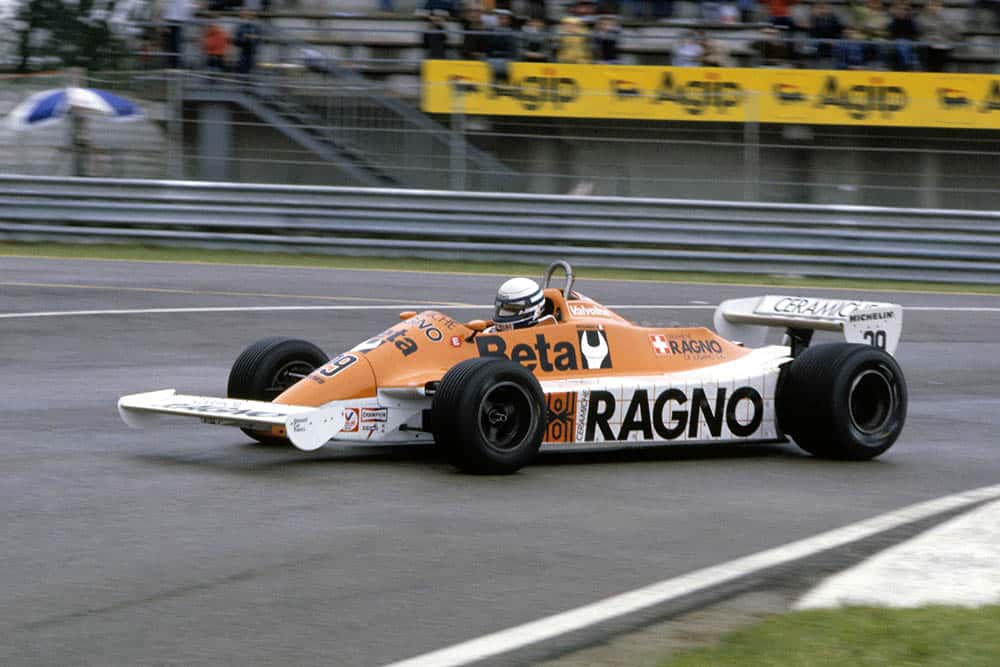
Riccardo Patrese finished an impressive 2nd in his Arrows
Motorsport Images
A very interesting race
Imola, May 3rd
To fill out the ranks of the Grand Prix races in the European part of the 1981 season the Italians came up with the splendid idea of holding a second event in Italy. As the International rules do not allow this unless the circuits are more than a specified distance apart (to allow two events in the USA) the Automobile Club of San Marino put in a claim for a Grand Prix as San Marino is an autonomous Principality within the Italian mainland. As San Marino is a recognised FIA country the claim was accepted and as there is no racing circuit within the Principality it was agreed to hold the first San Marino Grand Prix at nearby Imola. Everyone was delighted. While many of us prefer Monza for the Italian Grand Prix, where it will be run this year, there is nothing wrong with the present-day Imola circuit and nobody was going to complain about a second race in Italy. If you do not like motor racing in Italy you do not like motor racing.
Nothing is ever perfect these days, and the first thing was the banning of the Lotus 88 by an FIA Tribunal the previous week and Colin Chapman’s withdrawal of Team Lotus from the entry. Briefly, this came about from pressure from his “friends” and rivals in the other teams, over minute nit-picking on word definitions. When everyone presented themselves for the usual pre-practice scrutineering the Italian scrutineers said in so many words, “If you want to play silly b–s and nit-pick, all right” and they promptly disqualified all the cars except those of Renault, Talbot, and the new Toleman team. With Ferrari and Alfa Romeo thrown out the scrutineers could not be accused of being biased. The detail on which they caught everyone was that any specific part of the car influencing the aerodynamic performance of the car must remain immobile in relation to the vehicle. For a long time most designers have been using rubber sheet or plastic sheet to fill the gap between the bodywork and the rear wheels, or to form a rubbing strip on the bottom of the side-plates on nose fins, or as “trim” to the bottom edge of the side-pods. The chief scrutineer went round all the cars and tweaked these appendages between his finger and thumb and merely said “It moves”.
There was no defence. If the Frank Williams and Teddy Meyers of the Formula One world want to play silly b–s, let’s be really silly. Renault, Talbot and the new Toleman cars had no flexible edges so they were all right and Ferrari, Alfa Romeo and March soon removed theirs from the rear wheel areas, while other teams dutifully replaced flexible plastic or rubber with aluminium sheet. The teams of Williams, Tyrrell, Brabham, Osella, Fittipaldi and Arrows were all challenged on another point. In previous races this year the Brabham cars have been using a hydro-pneumatic suspension adjusting system which lowers the car from the regulation six centimetres ground clearance, once it is out on the circuit and at high speed. Once the rule was made about no more side-skirts which rub the ground, the limit of six centimetres was agreed upon as an arbitrary figure to use as a base line. The Brabham system was clearly dodging this rule but it was difficult to prove it. The other teams mentioned above all turned up with similar systems and the scrutineer did not say they were illegal, he merely asked the designers to explain what the system did and why they thought it was legal. Never a dull moment in Formula 1.
Qualifying
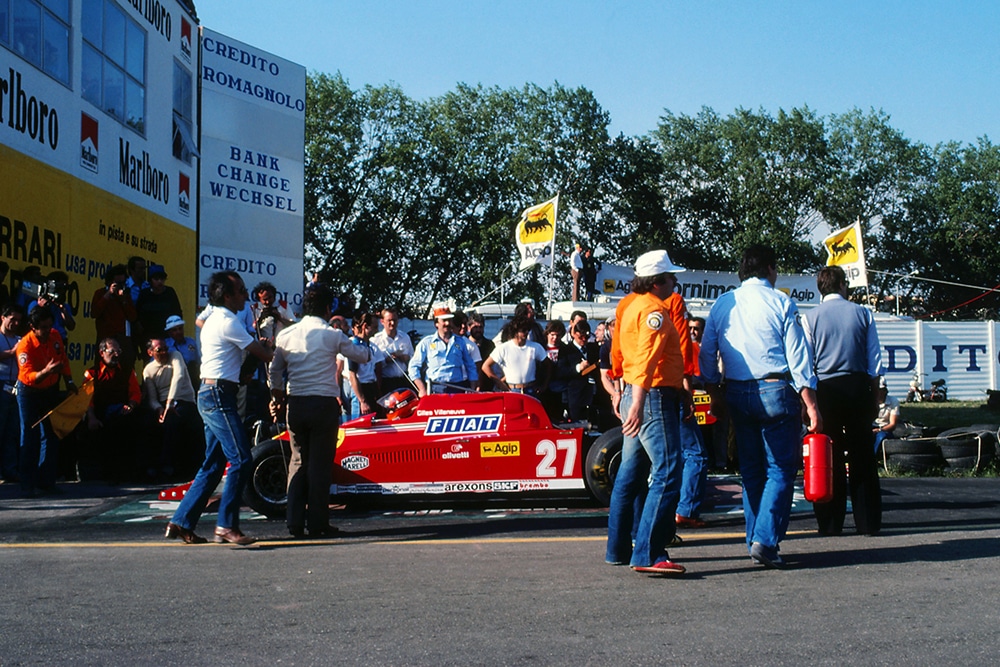
Tempers rose at the entrance to the pit-lane as officials checked cars for a mandatory 6cm gap after it was ruled that flexible skirts were illegal
© Motorsport Images
When the untimed practice session began on Friday morning the sun was shining, there was a big crowd as it was May-day holiday and most people had done the sporting thing and complied with the scrutineers’ demands without too much fuss. However, some of the small-minded little men in the circus who would rather be politicians than racing enthusiasts were huddled round little Bernie Ecclestone mumbling and grumbling about something or other and even though their cars were now legal, thanks to their engineers, they would not let their drivers practise. It was some sort of trade-union nonsense, a disease that many small-minded people suffer from.
The first two cars out on the track, to the delight of the crowd, were the two brand new Toleman-Hart TG 181 cars, driven by Brian Henton and Derek Warwick, resplendent in red, white and blue and carrying the Italian Candy firm’s advertising. When Ted Toleman made the decision to go into Formula 1 last year, after the team’s magnificent Formula 2 season he promised two cars for the start of the European season, which then was going to be in Belgium on May 17th. When this new race was put into the calendar there was no “wingeing” or excuses, the two new cars were ready. After the Tolemans had been round on their own others joined in, Tyrrells, Marches, Renaults, Alfa Romeos, Ferraris and Osellas. It all began to get under way but the cars of Williams, Brabham, McLaren, Talbot, Fittipaldi and Arrows remained locked away; it was their loss.
Due to the “stroppy” team managers or owners the programme for the day had to be reshuffled and there was an extra “test session” after lunch and the hour of practice for qualifying times was put back from 1 p.m. to 4.30 p.m. There were great smiles on the faces of the teams running turbo-charged engines, for a high ambient temperature is one thing the turbo-charged engine doesn’t like, and at 1 p.m. it was very warm. Before the crucial hour took place the organisers made it clear that cars would be checked for the six centimetres ground clearance before they left the pit-lane and as they returned to it, and at each end of the pits was a flat pad on which the cars had to stand while they were checked. In addition to this five observers were placed at crucial points around the circuit and if all five reported seeing a car running with its side pods close or touching the track, it would be thrown out. “If you want to play silly b–s … “
It did not take long for things to get really going, nor did it take long to see that Ferrari is rapidly getting on top of the turbo-charging problems. The turbo-charged Renaults and Ferraris dominated the whole session, if Arnoux wasn’t fastest then Villeneuve was, and vice-versa, and the only Cosworth-powered 3-litre to get among the 1 1/2 -litres was Reutemann’s Williams. The Argentinian was in top form and just destroyed the morale of anyone else in the unblown brigade. Not unexpectedly the Toleman-Harts were having troubles, Warwick having a turbo-charger burn out in the morning, due to mixture control problems, but both drivers were circulating and the basic cars and engines were working well. Ferrari had consumed one engine in the morning, on Pironi’s car, and in the afternoon Giacomelli’s Alfa Romeo V12 engine blew up and then the engine in the spare car broke. The Fittipaldi cars were running on the first supply of the new Avon racing tyres and everyone was very happy with Rosberg up in the first ten. There was some slight confusion when the March team drivers swapped numbers, but it was the final move (we hope) in a number muddle that has been going on since the season began.
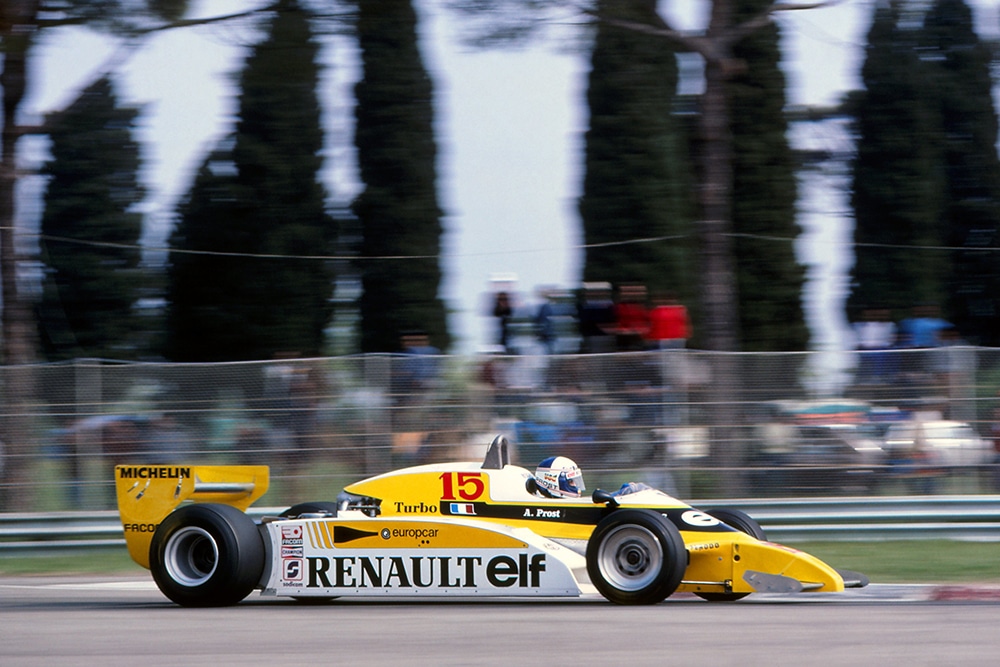
Alain Prost qualified 4th for Renault
Motorsport Images
Conditions were perfect for high speed driving and a lot of drivers were going way over the limit and spins and “breathless moments” were happening all round the circuit, but nobody hit anything. Laffite arrived in the pits with the fibreglass engine cover on the Talbot smouldering nicely, but more ominous was the trail of oil it was ‘leaving. Jabouille was comfortably in the running with the second Talbot-Matra V12 and there were no real surprises among the field of 30 runners; it would have been 32 if de Angelis and Mansell had been there with the Lotus team cars. This, of course, meant that six drivers were not going to start the race, as the grid is restricted to 24 cars. Three drivers were having their first attempt in Formula 1, Michele Alboreto (last year’s F3 Champion) in the second Tyrrell, Swedish driver Slim Borgudd in the second ATS and Derek Warwick in the second Toleman-Hart. Of the three Alboreto was doing very well.
When it was all over Arnoux was quickest with 1 min. 35.281 sec. which could be compared with his pole-position time of last September except that the first-gear “chicane” at the Acqua-Minerale corner has been eased to make it a second-gear “chicane”. So forget what went before and concentrate on today, for in second place was Villeneuve with the turbo Ferrari and in third place was Prost with the second turbo Renault. Turbo-charged 1 1/2-litres in the first three places, with Reutemann fourth in the Williams-Cosworth V8 and the second turbo-charged Ferrari in fifth place, followed by Jones in the second Williams-Cosworth V8. So maybe it was cool, which helped the turbos, and maybe Ferrari were tweaking the boost pressure up abnormally high to put the engine into “sprint” form, but the name of the game is winning and each practice session is a competition in itself for anyone who is out to win overall.
The five observers returned from around the track and said “Forget it, everyone, but everyone, is cheating. All the cars were touching the ground on the high speed corners” so that little problem was solved. Those that were not using adjustable hydro-pneumatic devices were using twin-rate spring arrangements where the first spring collapsed under the down-force applied by the bodywork. The first four cars were then checked for weight, which is a minimum of 585 kilogrammes and the Williams weighed 587, the Renaults 615 and 618 and the Ferrari 616. This, coupled to speed trap figures, made people rush off and calculate 550, 600, 650 or even 700 b.h.p. for the turbo-charged 1 1/2-litres which is good, because the whole point of an engine is to develop horsepower. Villeneuve was prepared to concede 570 b.h.p. for his Ferrari engine, if Reutemann would accept 495 b.h.p. for his Cosworth V8.
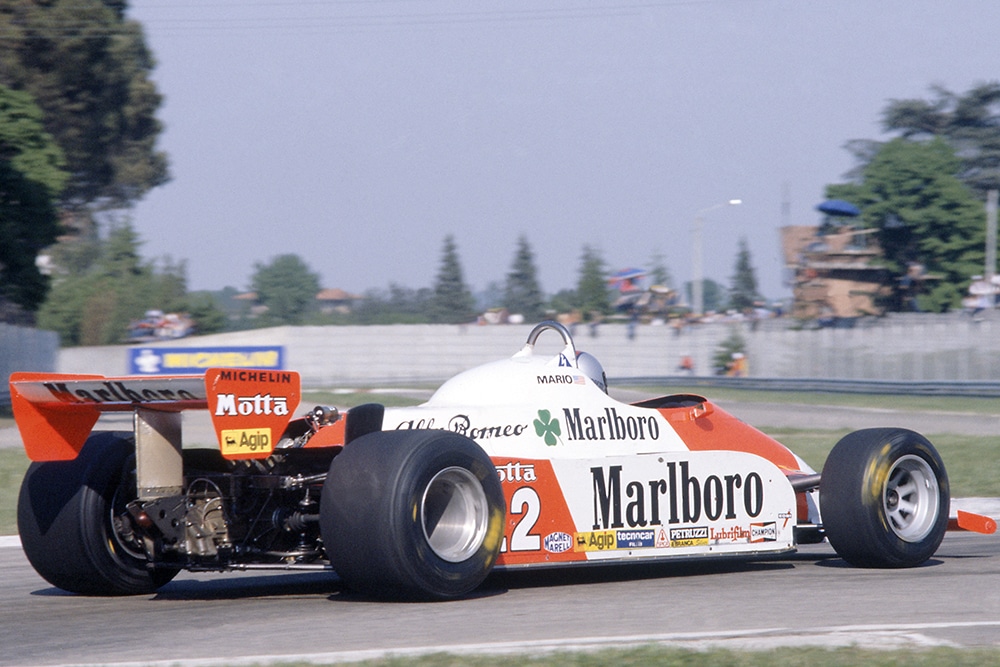
Mario Andretti found himself a disappointing 12th on the grid
Motorsport Images
On Saturday morning the sun was still warm and the world was at peace. The sheer weight of policing the rules by the organisers the day before had beaten everyone into submission and they were all getting on with the job properly. Brabham, Fittipaldi, Osella, Arrows and Tyrrell were still playing with “trick” hydro-pneumatic suspension, while Williams never did use theirs. The morning “test-session” went off all right and on the tyre front Michelin was still supplying most of the teams, if they could afford to pay for the tyres, while Fittipaldi were happy with their Avons and Toleman were content with their Pirellis. Engines were still suffering, for a lap speed approaching 120 m.p.h. doesn’t give them much respite. The Hart engine in Henton’s Toleman showed signs of devouring a piston so the car was withdrawn from the final practice hour as there was insufficient time to change it. Renault started up the car for Prost and the engine promptly lost its boost-pressure and when he got into the spare car that lost its pressure as well, so all the French hopes rested on Arnoux. The pace in the afternoon was as hot as the weather and Villeneuve and Arnoux were vying for pole-position, while Reutemamn sat and waited. Then the Argentinian joined in and promptly split the Ferraris, for Pironi had been right behind his team-mate and once Brabhams had got Piquet’s car working to their satisfaction the little Brazilian was up there with them.
Anyone watching the cars go by must have wondered what people are on about when they say “all Formula 1 cars are the same, it’s not like the good old days”. Renault turbo-charged V6 was followed by Alfa Romeo V12, by Ferrari turbo-charged V6, by Cosworth powered Williams, by Talbot-Matra V12 and feeling its way into this powerful scene the Toleman-Hart turbo-charged 4-cylinder; and there were drivers from all over the world, from Sweden to Chile, from Australia to Northern Ireland. There is nothing dull about Formula One. And as for driver ability, when you have Villeneuve, Arnoux, Reutemann, Piquet, Pironi, Jones and Andretti up at the front you can guarantee there is going to be some racing. Before this final hour was finished Reutemann decided that he could not beat Villeneuve’s fastest time, and was well satisfied with second place, so he changed out of his overalls into casual clothes and sat on the pit wall smiling benignly at his team-mate who was fast “losing his cool”. Alan Jones had problems with his gearbox to start with and while his mechanics feverishly put it right he went out in the spare car, only to find the handling not to his liking, then he went out in his own car again and when it was all over he ended up seventh fastest, behind John Watson in the latest McLaren MP4. When a driver starts talking about being held up by the traffic as an excuse, you might as well go and talk to someone else. Villeneuve, Reutemann, Arnoux, Piquet and Pironi all managed pretty well in the same traffic.
Race
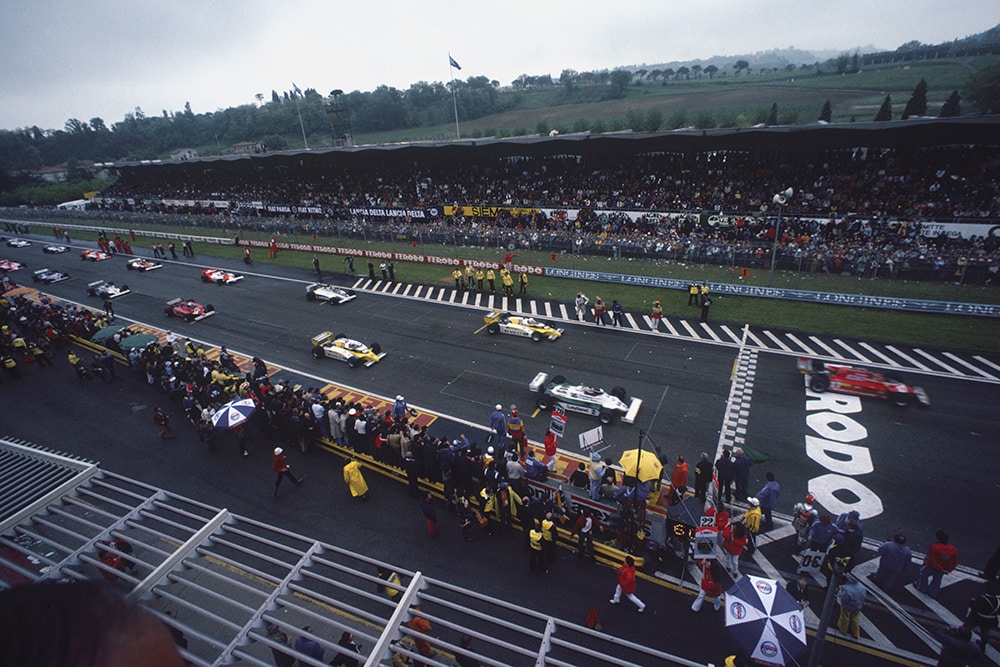
Gilles Villeneuve leads the field away on the formation lap
Motorsport Images
If your affections lay with turbo-charging, with Ferrari, with Villeneuve, with Williams, with Reutemann, with Arnoux or with Renault you could not help being happy on Saturday evening, at least until it got dark, for then the thunder and lightning began and the rain started. On Sunday morning it was very wet, but by mid-day the rain had stopped though the skies were still gloomy and there seemed little chance of the weather improving. During the half-hour warm-up session Prost was in the spare Renault, Watson was in the original MP4 McLaren while the new one was having its engine changed, both Ferraris were in short wheelbase configuration with new engines installed, running on a lower boost pressure as evinced by the waste-gate spring pressure adjusting screw and Fittipaldi had some wet-weather Avon tyres that looked suspiciously like Goodyears! The start was not due until 3 p.m. and as that time approached and cars were made ready the choice of “wet” or “dry” tyres was still wide open, for it was not raining and there was just a chance that it might stay dry. As the twenty-four drivers set off on the warm-up lap round to the grid, they left behind them six disappointed drivers who had not qualified, Stohr (Arrows), Daly (March), Lammers (ATS), Serra (Fittipaldi), Warwick (Toleman) and Henton (Toleman).
After some dickering about on the grid the scene ended up with only three cars gambling on starting on dry-weather tyres, Rosberg, Tambay, and Surer, and the rest were wondering how long their treaded tyres would last if it did not rain. Villeneuve led them away on the “parade” lap to the accompanying shouts and applause of the very partisan crowd. They all arrived safely back on the grid, except that Prost was already in trouble, his gearbox having broken first gear. As the back-markers came to a stop the red light came on and almost instantaneously turned to green in one of the quickest starts we have ever seen. Everyone got away, the two turbo Ferraris going straight into the lead, with the two Williams right behind them, Jones having made a meteoric start from the fourth row. It was joy day for Italy as Villeneuve and Pironi led the race, but already others were in trouble for Guerra (Osella) had been shuffled off the track and in the crash had injured himself in the leg, while poor Prost was right at the back of the field with his gearbox making horrid noises. Some people had given the turbo Ferraris a life of five laps in the lead, others had exaggerated as far as 12 laps in the damp conditions. At five laps the order was Villeneuve, Pironi and it was the same at twelve laps, the two squat Ferraris looking to be in complete control, which is more than can be said of some of the other competitors.
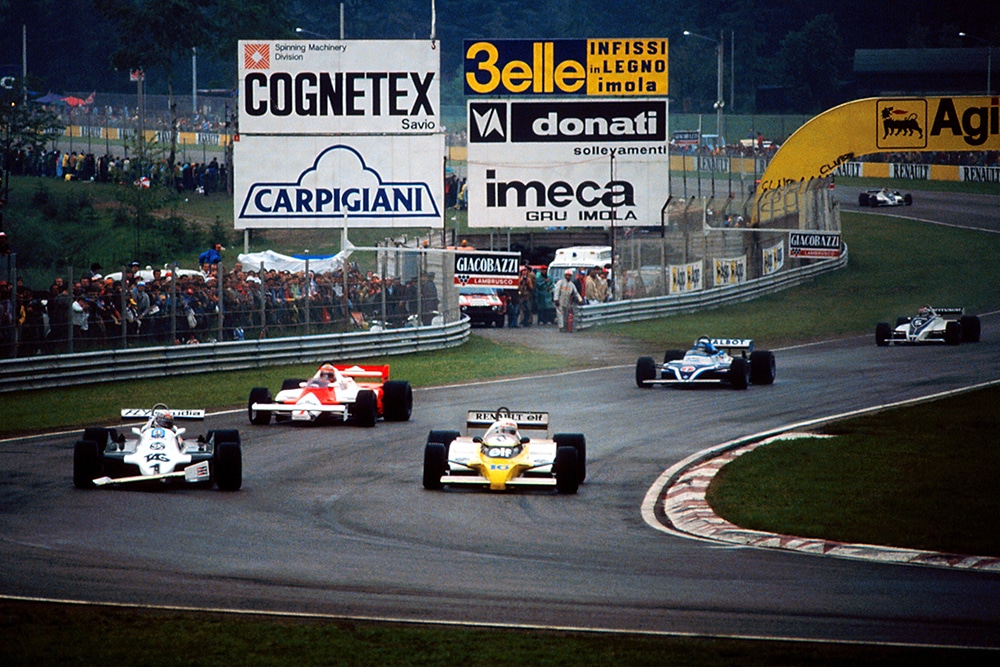
After damaging his front wing, Alan Jones is overtaken by Rene Arnoux
Motorsport Images
Alan Jones hit his team mate up the tail and while Reutemann continued unhurt the World Champion had to stop at the pits for a new nose cone and while he was in, the car was changed on to “slick” tyres as the track was drying out quite fast. Watson tried to drive through on the inside of Arnoux’s Renault, on the left-hander by the pits, and seemed to forget about the vast aerofoil stuck out the front of the MP4 and it got wiped off on the Renault’s left rear wheel, which made the Ulsterman return to the pits on the next lap for a new nose and aerofoil. Prost retired with a wrecked gearbox and Laffite retired with bent front suspension when he also savaged Arnoux’s Renault, as Watson had done, and come off second best. Poor Arnoux was now handicapped by a bent wheel and a broken exhaust pipe but decided to carry on. Reutemann was limited on how hard he was prepared to drive by a worrying vibration which may, or may not, have been emanating from tyres moving on the rims, so Patrese was able to pass him and take third place on lap 6. The Italian crowd could not ask for more, a Ferrari in the lead, a Ferrari in second place and an Italian driver in third place.
In the opening laps Villeneuve was finding his car tricky to drive as the power characteristics of his new engine gave all the power rather suddenly at the top end of the r.p.m. range. There was no lack of power, it was merely a bit sudden and this made it difficult to drive smoothly so Villeneuve was conscious of giving his rear tyres a hard time. When he came up to lap Jones and Tambay, the Williams driver having rejoined the race in 19th position, Villeneuve merely pulled out and ran round the outside aof them on the long left-hander after the pits. There was no shortage of power in the Ferrari. From his pit signals he could see that Patrese was gaining on both him and Pironi and as the track was now nearly totally dry he assumed that the Arrows A3 was not consuming its rear Michelin “wets” so quickly as the Ferraris were. From what he could see of the sky it looked as though it was going to continue drying up so at the end of lap 15 he dived into the pits for dry-weather Michelins, leaving Pironi to hold the Fort, which he did admirably. The stop was not one of the Ferrari team’s best efforts and Villeneuve rejoined the race in 13th place and covered one lap to find the rain had started again, so immediately shot back into the pits for another set of “wet” Michelins and rejoined the race again almost a lap behind Pironi. Meanwhile Jones, Tambay, Watson and Surer all stopped to change over to “wet” Michelins.
While all this had been going on it could not be missed that Nelson Piquet and the Brabham were looking very smooth and very confident. Piquet had not made the best of starts and was ninth on the opening lap, slightly hemmed in by some mid-field runners, but he soon got clear of them and joined the leaders in fifth place by lap seven and then passed Reutemann to take fourth place, and with Villeneuve stopping at the pits Piquet was hoisted up into third place, not too far behind Patrese. Six laps were all he needed to catch and pass the Arrows A3 and take second place and now Pironi was not so happy in the lead. Being followed by Patrese in an Arrows A3 is one thing, to be followed by Piquet in a Brabham is something else altogether. No doubt Pironi wished his team-mate was up there to help him, but the little French-Canadlian was down in 12th place, but going like a ding-bat as always. The rain was stopping but the track was not drying so it was a question of how long wet-weather Michelins were going to last. Rosberg never got a chance to try the Avon “wets” as his Cosworth V8 blew up on lap 15.
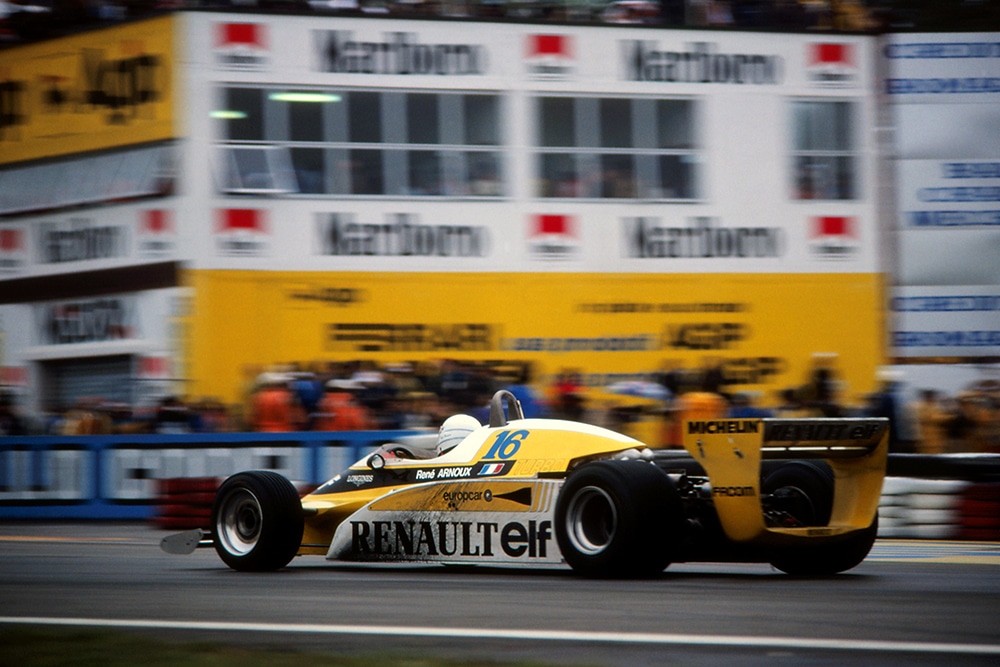
Arnoux finished outside the points
Motorsport Images
We were now at half-distance, which was lap 30 and a turbo-charged Ferrari was still in the lead, and the second one was lapping faster than anyone else in the race. Anyone with the future at heart must have been very concerned. The Alfa Romeo fans were totally depressed for neither Andretti nor Giacomelli had been in the picture from the very start; Andretti had retired with gearbox trouble and now Giacomelli ran into Cheever, while the Tyrrell driver was trying to overtake and both cars were damaged and put out of the race. At the back of the field Tyrrell’s new-boy Alboreto was doing quite nicely in his first Grand Prix and was holding off Gabbiani’s Osella until lap 32 when they literally “fell over each other”.
At the front Pironi was more than aware that Piquet had him all lined up in his sights, but he could not do anything about it as his rear tyres were wearing badly and limiting his performance. Earlier, he had lapped Tambay in the Theodore and the Frenchman had nipped in behind and got a tow from his compatriot’s red car. When Tambay saw Piquet getting closer in his mirrors he got really close to the back of the Ferrari and sat there for three of four laps until he felt that Piquet was ready to pounce on the Ferrari. Then as they left the right-hander by the pits Tambay pulled out alongside the Ferrari, as if he was going to try and overtake, leaving the place clear for Piquet to slot into, and then pulled the Theodore back in behind the Brabham, thus maintaining his tow. It was a delightfully intelligent and calculated manoeuvre so typical of the character of Patrick Tambay.
Two laps later when Patrese’s Arrows appeared in the Theodore’s mirrors the Frenchman gave way in a similar clean-cut and clear move. Reutemann was still in fourth place and a fair way back in fifth place came Hector Rebaque doing a neat and tidy job in the number two Brabham. Behind him was Andrea de Cesaris in Watson’s old M29F McLaren having an excellent drive, after mixing-it with the two Alfa Romeos he got away from them and also got past the ailing Renault of Arnoux. Behind them all Villeneuve was gaining ground rapidly, setting the fastest race lap on lap 46, just after he moved up into seventh place. As the Ferrari at the back of those who were all on the same lap was gaining ground, the Ferrari at the front was losing it and Piquet went by into the lead on lap 47 and two laps later Patrese relegated Pironi to third place.
It was clear that the Cosworth powered cars were easier to drive on balding rear Michelin wet-weather tyres, than the turbo-charged Ferrari, and of course, Villeneuve had the advantage of a new set of tyres at his second stop. It had not rained any more but the track had not really dried out. As poor Pironi was forced down to fourth place by Reutemann, Villeneuve moved up to, sixth place, ahead of de Cesaris and started to aim for Rebaque’s fifth place. As Alan Jones said in 1979 “that guy never gives up”. At this point Watson was also going very quickly, relative to the conditions, and recorded the second fastest race lap, but he was two laps down on the leaders. Before Villeneuve could do anything about Rebaque the Ferrari’s clutch started to slip, so that was that, and anyway the young Mexican was not waiting to be caught and as they started the last lap he slipped neatly past the ailing Pironi to take a well-earned fourth place. The immaculate and unruffled Nelson Piquet had driven yet another wise, intelligent and smooth race in a style that is fast becoming his trade-mark. You could not argue about Patrese’s second place and the performance of his Arrows, even if you had wanted to, while Reutemann’s third place scored his 14th successive finish in World Championship races, everyone of them in an honourable position. Villeneuve was the hero of the meeting as far as the Italian public were concerned, even though the clutch slip dropped him back to seventh place and he had to be pushed in at the end of the slowing down lap. An unhappy Alan Jones finished down at the back, his mistake and two tyre stops putting him out of reach of the “racers”. A neat and tidy drive was that of Marc Surer in the Ensign, who had started on “slicks”, stopped to change tyres and kept going nicely into ninth place, only one lap down on the winner, while the Swedish driver Borgudd must have been pleased to qualify and finish at his first attempt at Formula One.
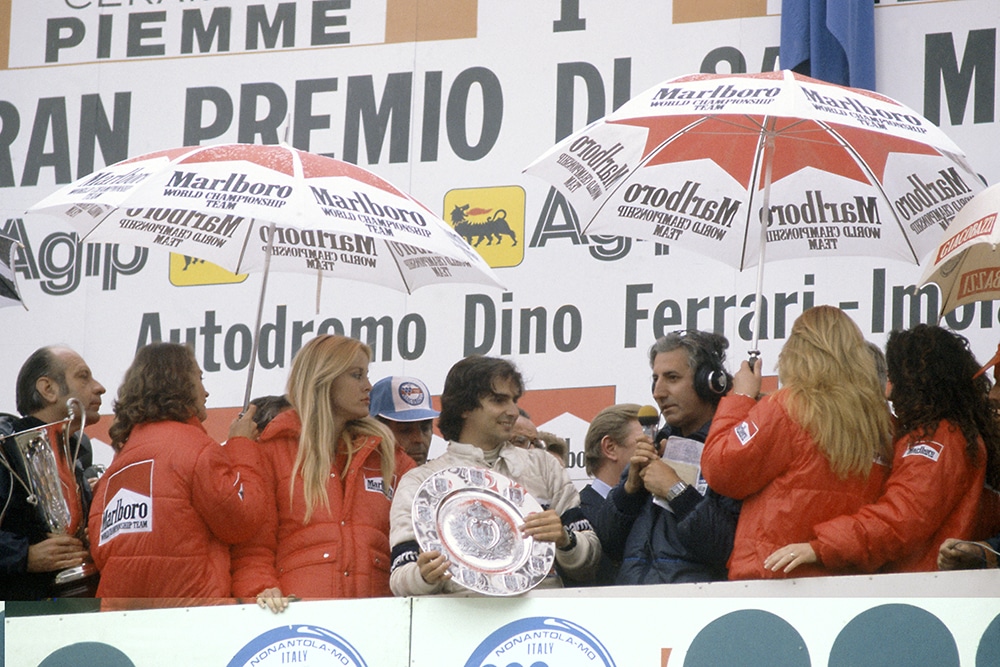
Nelson Piquet shows off his plate on the podium
© Motorsport Images
Two Ferraris at the start, two at the finish, pole-position, fastest race lap and in the lead for 46 of the 60 laps would indicate that the Scuderia Ferrari are on their way back to the top. A Ferrari is still a Ferrari no matter what shape it is or what sort of noise it makes, and it is red. After all the “businessmen’s” quarrelling during the previous three days once they let the “racers” get on with the job all was well with the world for we have a good bunch of lads up at the front. Once the race started everything was fine, so what we want is more racing and less practice. The best way of stopping an argument or a union-meeting is to start up a Cosworth DFV engine. We should do it more often. – D.S.J.
